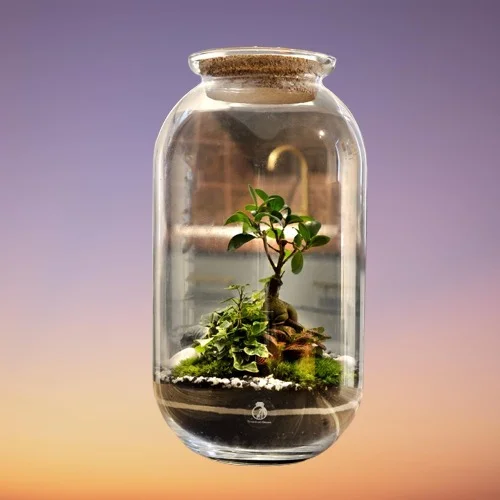15 Best Plants for a Closed Terrarium that are Ideal for a Beginner
Some links in this post may be affiliate links
Plants that are ideal for a closed terrarium are moisture-loving or humidity-loving plants which require a constantly warm, moist atmosphere to thrive.
A closed terrarium or bottle garden is always more humid than the surrounding atmosphere which makes it an ideal environment to grow the delicate moisture-loving plants. A terrarium is one of the common methods by which you can display your indoor plants.
15 Indoor Plants for a Closed Terrarium
The best plants for a closed terrarium ideal for beginners are Creeping Fig, Fittonia, Polka Dot, Selaginella, Parlour Palm, Maranta, Earth Star Bromeliads, Aluminium Plant among others.
1. Creeping Fig (Ficus pumila)

Creeping Fig also called Climbing Fig is one of lowly Ficus varieties and is useful as a trailer or climber as it produces a dense green carpet and is one of the best ground covers.
Ficus pumila prefers medium to bright indrect light away from direct sunlight and warm and humid conditions like those present in a closed terrarium.
The soil needs to be consistently moist, fertile, well-drained and coupled with monthly feeding during the growing season.
Read more on how to grow and care for Creeping Fig (Ficus pumila)
2. Nerve Plant (Fittonia)
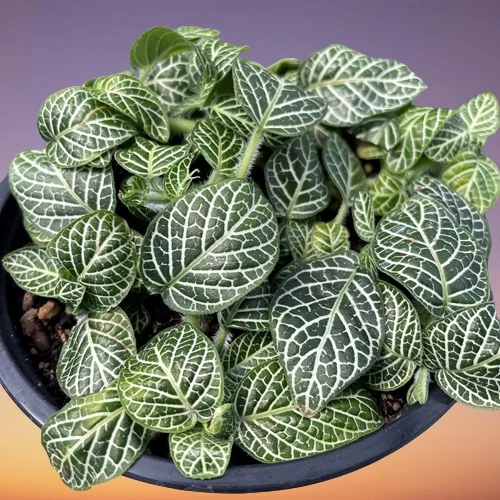
Nerve plant is a popular, moisture-loving plant that is highly adaptable to low light conditions; the plant is perfect for a closed terrarium.
Nerve Plant also called Net Plant, Lace leaf or Snakeskin is easily recognisable due to its leaves which bear a network of white, pink or red veins.
Fittonia is an easy-care plant ideal for a beginner plant parent. It requires medium to bright indirect light away from direct sunlight, warm and humid conditions and consistently moist, rich, well-drained soils.
Learn more on how to grow and care for Nerve Plant (Fittonia)
3. Parlour Palm (Chamaedorea elegans)

Though Parlour Palm will adapt to a wide range of growing conditions, it does very well in warm, humid conditions.
These coupled with its small compact growth makes Chamaedorea elegans an ideal plant for a closed terrarium where the warm and humid conditions can be maintained.
Parlour Palm has a high tolerance for low light and artificial light. However, it prefers bright indirect light and rich, well-drained soils.
Read more on how to grow and care for Parlour Palm (Chamaedorea elegans)
4. Polka Dot Plant (Hypoestes phyllostachya)

Polka Dot also called Freckle Face is a low-growing beautifully colored plant that is easy to grow and care for if given the right growing conditions.
The Polka Dot plant has a high requirement for humid conditions and is thus ideal for growing in a closed terrarium.
There are many varieties of Freckle Face available like Pink splash which is green and pale pink. Red splash which is green and red. White splash which is green and white among others and are spectacular in a terrarium.
Learn how to grow and care for Polka Dot Plant (Hypoestes phyllostachya)
5. Creeping Moss (Selaginella)
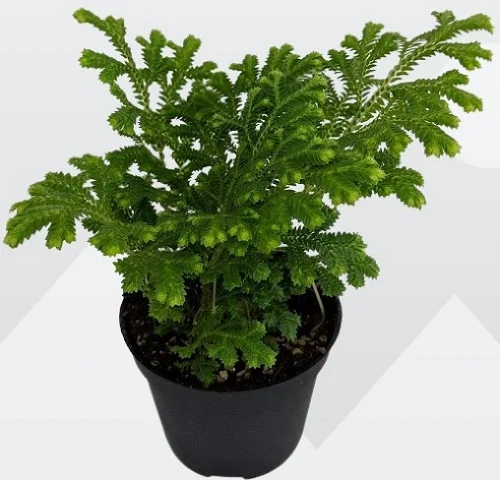
Creeping Moss is a creeping plant with simple, scale-like leaves borne on branching stems from which the roots arise and is ideal for a terrarium as its tiny leaves will shrivel in ordinary room conditions.
Some of the common species of Selaginella are the trailing types like Selaginella uncinata (Blue-green Peacock Fern), Selaginella apoda and Selaginella kraussiana aurea.
The upright types include Selaginella martensii (Spike Moss) and Selaginella emmeliana. Another common species is the resurrection-plant, Selaginella lepidophylla which is bought as a dried-up ball and is restored to life by soaking in water.
6. Brown Spiderwort (Siderasis fuscata)
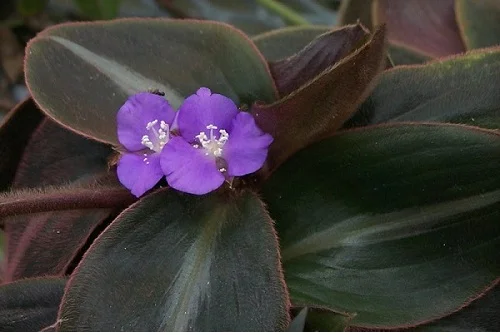
Brown Spiderwort or Bear Ears Plant is a small plant whose short bronze-colored leaves form a rosette and is a moisture-loving plant ideal for a terrarium.
The spectacular, bronze-colored foliage in Brown Spiderwort will add a contrast to the greenery in a terrarium.
Siderasis fuscata exhibits some characteristics similar to those of a Tradescantia Plant thus was intially classified under Tradescantias under the synonym Tradescantia fuscata.
Learn how to grow and care for Brown Spiderwort (Siderasis fuscata)
7. Maranta Plants (Maranta leuconeura)
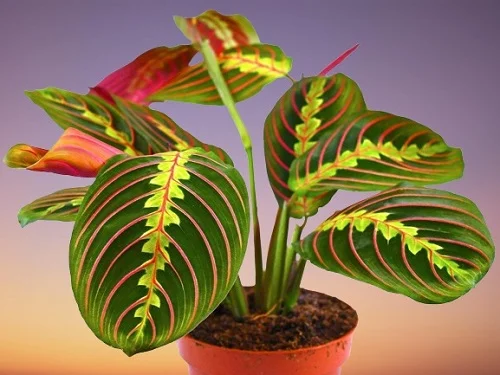
Maranta Plants are humidity-loving plants ideal for a closed terrarium where high moisture levels can be maintained.
Being low-growing plants which bear spectacularly patterned leaves, they are an excellent addition of color in a terrarium.
Some of the common varieties of Maranta Plants include Maranta tricolor (Herringbone Plant) with prominent red leaf veins, Maranta leuconeura kerchoveana (Rabbit's Tracks) with brown leaf blotches which turn green with age and Maranta leuconeura massangeana with blackish green leaves and silvery veins among others.
Learn how to grow and care for Maranta Plants (Maranta leuconeura)
8. Calathea fasciata (Goeppertia fasciata)
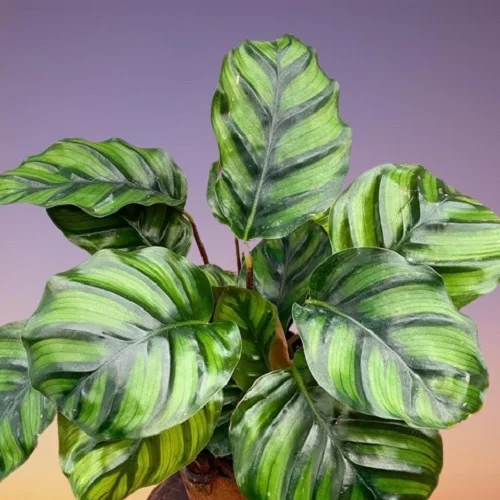
Calathea fasciata also called Goeppertia fasciata is among the popular Calathea varieties on account ot its glossy, orb-shaped, deep-green leaves with lime-green rib variegation and purple undersides which radiate from the center of the plant.
It grows in clumps to a height of about 1-2 feet. On account of its compact size and affinity for humid conditions, Goeppertia fasciata along with its cousins Calathea vittata (Goeppertia elliptica), Calathea picturata (Goeppertia picturata) and Calathea bachemiana (Goeppertia bachemiana) are some of the best plants for a closed terrarium.
Calathea fasciata blossoms in medium indirect light, average warmth of 17-260C, humidity of 60-80% and moderately moist, rich, well-drained, all purpose soil coupled with monthly feeding in the growing season.
Learn more on how to grow and care for Calathea fasciata (Goeppertia fasciata)
9. Earth Stars Bromeliads (Cryptanthus Bromeliads)

Cryptanthus Bromeliads are stemless, terrestrial, low-growing, moisture-loving Bromeliad varieties whose small, wavy-edged, colorful leaves make spectacular plants in a terrarium.
Earth Stars are a unique group of Bromeliads in that they only grow terrestrially in soil. Unlike other Bromeliads, Earth Stars root systems are more developed and they do well in well-drained, moisture-holding soils.
Earth Star Bromeliads flourish in bright light away from direct sunlight, average warmth of 18-260C, humidity of 60-70% and moderately moist, rich, well-drained, orchids potting soils coupled with fortnightly feeding during the growing season.
Learn how to grow and care for Earth Stars Bromeliads (Cryptanthus Bromeliads)
10. Polynesian Ivy Vine (Pellionia repens)
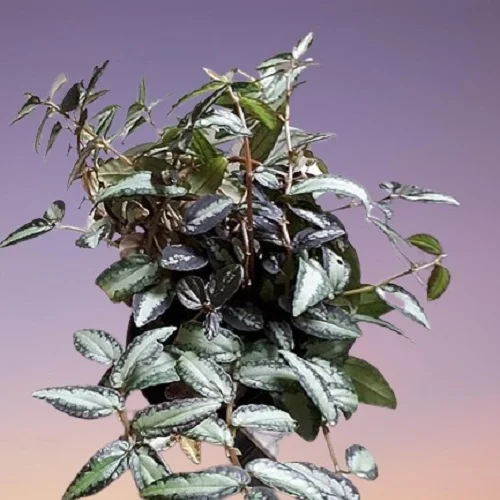
Polynesian Ivy Vine is a moisture-loving, low-growing vine which bears beautifully shaped and colored leaves.
Each leaf has a pale central band and the outer margin may be olive or bronzy green which offer a sight to behold in any space.
Pellionia repens and its cousin Pellionia pulchra (Satin Pellionia) are a great choice for a closed terrarium as they provide a spectacular display with their charming foliage.
Learn how to grow and care for Polynesian Ivy Vine (Pellionia repens)
11. Alocasia 'Black Velvet' (Alocasia reginula)
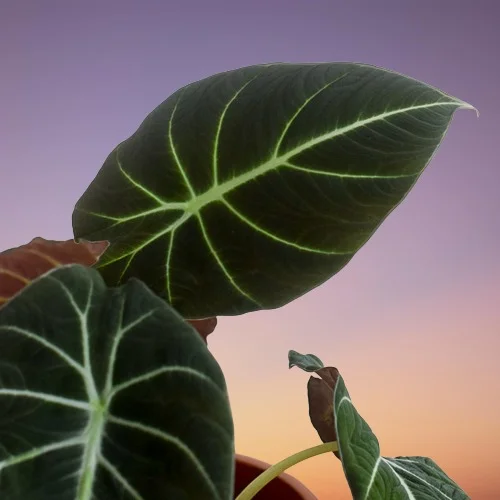
Alocasia 'Black Velvet' also called Little Queen is among the popular Alocasia varieties and bears broad, heart-shaped, dark-green leaves with a velvety background, pale green, white or silver veins and reddish undersides.
Little Queen and its cousins Alocasia cuprea (Jewel Alocasia) and Alocasia X amazonica 'Polly' (African Mask) are some of the best plants for a closed terrarium on account of their compact size and affinity for high humidity.
Alocasia reginula blossoms in medium to bright indirect light, average warmth of 16-270C, humidity to 60-80% and moderately moist, rich, well-drained, aroids potting soils coupled with monthly feeding during the growing season.
Learn how to grow and care for Alocasia 'Black Velvet' (Alocasia reginula)
12. Aluminium Plant (Pilea cadierei)

Aluminium Plant or Watermelon Pilea is an evergreen plant which bears dark-green oval leaves, each bearing raised silvery patches.
The Watermelon Pilea is a low-growing plant which grows to a height of 1 foot only and 18 inches wide making it ideal for a closed terrarium.
The beautiful leaves in Pilea cadierei will provide a spectacular contrast of colors inside a terrarium.
Learn how to grow and care for Aluminium Plant (Pilea cadierei)
13. Baby's Tears Plant (Soleirolia soleirolii)
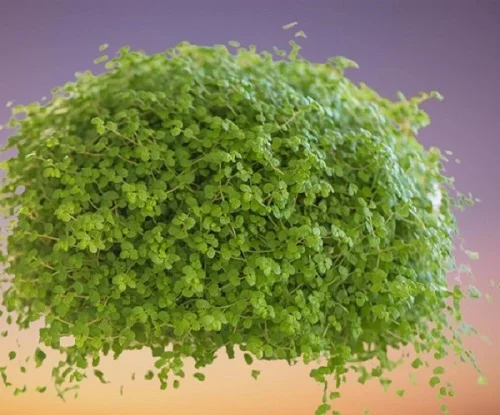
Baby's Tears Plant also called Angel's Tears Plant or Mind Your Own Business is among the popular fast-growing plants and is ideal for a hanging basket or for covering soil around tall plants but care should be taken as the plant can smoother low-growing plants.
On account of its requirement for high humidity and warm conditions, Angel's Tears Plant is among the best plants for a terrarium as high humidity can be maintained inside a terrarium.
Soleirolia soleirolii thrives in bright indirect light, average warmth of 15-240C, humidity of 70-80% and consistently moist, well-drained, all purpose soil that is rich in organic matter coupled with fortnightly feeding during the growing season.
Learn how to grow and care for Baby's Tears Plant (Soleirolia soleirolii)
14. Beetle Peperomia (Peperomia angulata)
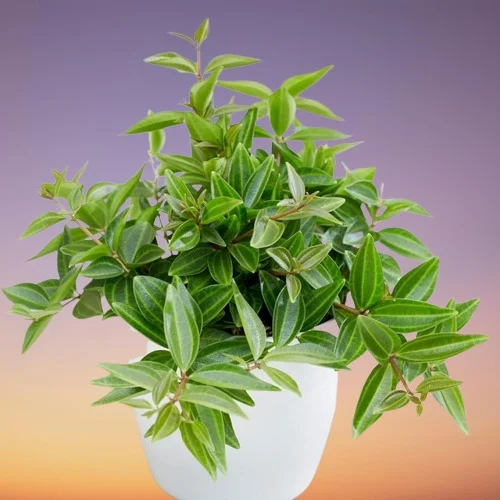
Beetle Peperomia also called Beetle Raditor Plant is among the popular Peperomia varieties and bears fragile reddish stems and fleshy, glossy, oval-shaped, dark-green leaves with light green lines and look like small Beetles, hence, the common name.
On account of its compact size and affinity for high humidity, Peperomia angulata and its relatives Peperomia caperata (Emerald Ripple Peperomia), Peperomia argyreia (Watermelon Peperomia), Peperomia glabella (Wax Privet Peperomia), Peperomia orba (Teardrop Peperomia) and Peperomia clusiifolia (Peperomia Ginny) are among popular plants for a closed terrarium.
Peperomia angulata thrives in medium to bright indirect light away from direct sunlight, average warmth of 15-260C, humidity of 60-70% and moderately moist, rich, well-drained, all purpose potting mix coupled with monthly feeding during the growing season.
Read more on how to grow and care for Beetle Peperomia (Peperomia angulata)
15. Lemon Button Fern (Nephrolepis cordifolia 'Duffii')
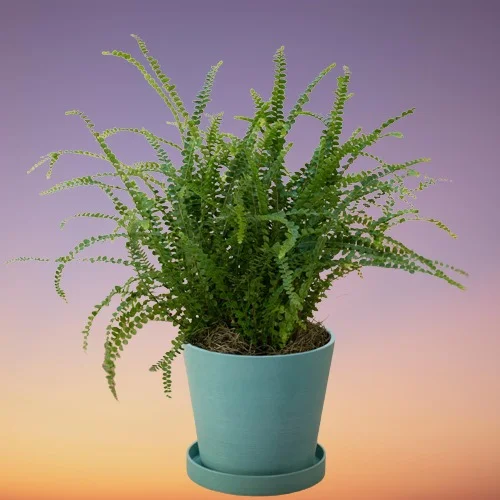
Lemon Button Fern also called Button Sword Fern, Fishbone Fern or Little-leaved Sword Fern is a compact, small-sized, hardy fern which bears gracefully drooping stems.
On account of its compact growth and requirement for warm humid conditions, Little-leaved Sword Fern like Maidenhair Fern (Adiantum raddianum) is perfect for a terrarium where these conditions can be provided inside a terrarium.
Nephrolepis cordifolia 'Duffii' is native to the Pantropical regions of the world where it grows in swampy, damp, forest-like conditions.
Learn how to grow and care for Lemon Button Fern (Nephrolepis cordifolia 'Duffii')
What is a Closed Terrarium?
A closed terrarium is a glass or transparent container inside which plants are grown. The top is naturally restricted or covered with a transparent material.
The closed terrarium completely surrounds the plants and as a result keeps off the plant-killing drafts.
The air within a closed terrarium is always moister than the room atmosphere which makes it perfect for growing the delicate plants which may require high humidity and protection from drafts.
Some containers that are ideal for a closed terrarium include a fish tank, a large bottle or even a large mixing bowl.
The only requirement is to have transparent sides and a restricted opening or an opening that can be covered with a transparent material. There are many types of beautiful closed terrariums on Amazon to choose from.
How to Select Plants for a Closed Terrarium
While selecting plants for a closed terrarium, select a variety of plants that vary in height, growth habits and texture in order to have an interesting landscape.
Select plants that have close or similar light requirements inorder to make it easier to maintain your plants thriving.
Avoid flowering plants as flowering plants have different light requirements through out the year.
If you select flowering plants for your closed terrarium, it will be difficult to remove dead flowers when they are spent.
Most flowers also require good air circulation in order to prevent powdery mildew and fungal diseases, a situation that is not feasible in a closed terrarium.
How to Prepare Plants for a Closed Terrarium
To prepare the plants for the terrarium; pinch off the growing tips and prune tall and spreading types to minimize their size. Remove dead and yellow foliage.
Check the plants for pest and disease infestations; do not use any infested plant as using them will introduce these infestations in the terrarium environment and they will be difficult to control.
How to Care for a Closed Terrarium
The two most fundamental care practices for a closed terrarium are watering and light requirements. Keep reading for more on these two practices.
How to water plants in a closed terrarium
Ensure the soil is moist at all times; water sparingly. In most cases if the terrarium is well covered, watering will not be necessary as there is minimal evaporation and the plants form their own ecosystem inside the terrarium.
If there is condensation on the inside of the glass soon after planting, open the terrarium to allow excess moisture to evaporate.
Light for plants in a closed terrarium
Place the terrarium in a bright spot but away from direct sunshine to avoid cooking the plants. Plants in a terrarium can also thrive under artificial light.
